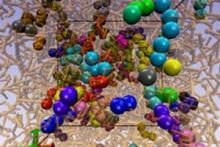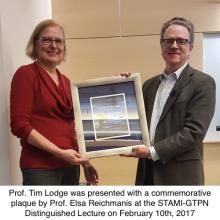

Collective motion and relaxation in glass-forming polymeric liquids are investigated in molecular dynamics (MD) simulations of bulk polymer, thin polymer film and nanocomposite materials. The physical arguments underlying the Adam-Gibbs (AG) model of glass-formation are summarized and we then test whether collective particle exchange motion exists as predicted by AG and whether this model can rationalize the highly variable temperature dependence of the structural relaxation time found in this broad family materials. We observe string-like excitations involving particles undergoing collective exchange motion that we directly identify with with the abstract “cooperatively rearranging regions” of AG (see figure below and Refs. 1 - 3 for discussion). Further, we verify this correspondence by quantitatively describing all our relaxation data based on our extended AG model (string model of glass-formation) and the empirically determed high tempearture Arrhenius activation parameters of transition state theory. Finally, we confirm the predicted inverse relation between the mass of the dynamic strings and the fluid configurational entropy that underlies the AG model. The implications of this model extend far beyond glass-forming polymer liquids; we show the same type of collective motion arises in grain boundaries of crystalline materials, the interfaces of crystals, the interfacial dynamics of nanoparticles, superheated crystals, and in biologically relevant materials such lipid membranes and the internal dynamics of proteins and arises in materials ranging from metallic glasses to polymer materials. Evidently, string-like collective motion is relevant to understanding relaxation in diverse condensed materials.

The short average service life of traditional dental composite restoratives and increasing occurrence of secondary caries adjacent to composite restorations and sealants are necessitating the development of new, longer lasting dental materials. Our approaches to make the next generation dental resin composites incorporate novel functions into the three major components of resin composite restoratives: resin networks, fillers and adhesives. We invented an ether-based resin network, which is enzymatically and hydrolytically stable. We discovered a new photo-polymerization approach to avoid composition shift caused by diffusion limitation during the forming of cross-linking resin network. The resin composites made with these new resins and resin networks are significantly stronger and tougher than the BisGMA/TEGDMA controls. We successfully incorporated the self-healing capability into the filler system to achieve autonomous healing of micro-cracks. These cracks may lead to failure of dental restorations, but are very difficult to detect almost impossible to repair manually. Our new self-healing dental composites increased the fatigue life up to five times comparing with the control. We will also introduce a pH-sensitive antimicrobial compound which will provide the needed antibacterial capability when local environment becomes acidic. Specifically, this new compound has an acid-induced, pH-controlled reversible switching antibacterial activity. Overall, our team has made significant improvement to the dental resin composites by using stable ether-based resin network, incorporating self-healing capability, and delivering environment triggered antimicrobial components.

Polymers are ubiquitous in our modern society, and the fact that polymer properties can be widely manipulated by altering the constituent repeat units, their arrangement, and macromolecular size drives their use across a spectrum of technologies. Polymer-based additive manufacturing, or 3D printing, recently has gained traction as a rapid and efficient mode of manufacturing. However, 3D printing using polymeric materials is often challenged by a limited scope of feedstock materials and weak interfaces in printed parts. In response to these challenges, we have focused on using polymer- and copolymer-grafted nanoparticles as way to affect organization and improve macroscopic properties of 3D printed nanocomposites created by fused deposition modeling (FDM).
Specifically, an increase in interfacial interactions due to surface-tethered polymer chains enhances thermomechanical properties of FDM-printed parts beyond simple nanocomposites while retaining dispersion. In addition, random copolymer composition offers a miscibility dial that facilitates dispersion in matrices in which miscibility would otherwise not be expected. The design-structure-property relationships resulting from this work as well as the central idea of encoding instructions in tethered chains arrayed at nanoparticle surfaces to control organization and properties are conceptually important and expected to inform efforts to produce hybrid systems with enhanced performance for polymer additive manufacturing.
Marine organisms use organic building blocks in unique ways to achieve materials with exceptional properties. With inspiration from these natural systems, the design of synthetic building blocks to mimic these capabilities and extend them to common polymeric materials will be described.
Please join us on June 29, 2017 in the Molecular, Science and Engineering Building (MoSE) Conference Room 3201A for our 2017 STAMI Fellowship Award Program. During the event the 2017 STAMI Fellows will present on the results of their research and receive an award. The event will be followed by a networking reception for all attendees.
We study the optimal packing of hard spheres in an infinitely long cylinder [1-4]. Our simulations have yielded dozens of periodic, mechanically stable, structures as the ratio of the cylinder (D) to sphere (d) diameter is varied. Up to D/d=2.715 the densest structures are composed entirely of spheres which are in contact with the cylinder. The density reaches a maximum at discrete values of D/d when a maximum number of contacts are established. These maximal contact packings are of the classic "phyllotactic" type, familiar in biology. However, between these points we observe another type of packing, termed line-slip.


Ionic liquids are an emerging class of solvents with an appealing set of physical attributes. These include negligible vapor pressure, impressive chemical and thermal stability, tunable solvation properties, high ionic conductivity, and wide electrochemical windows. In particular, the non-volatility renders ionic liquids practical components of devices, but they require structure-directing agents to become functional materials. Block polymers provide a convenient platform for achieving desirable nanostructures by self-assembly, with lengthscales varying from a few nanometers up to several hundred nanometers. Furthermore, ionic liquids and polymer blocks can be selected to impart exquisitely tunable thermosensitivity, by exploiting either upper or lower critical solution transitions (UCSTs and LCSTs).
A series of lectures in modern nanostructural polymer science and it's applications. Please note the dates and times of the individual lectures: Lecture 1: November 7, 12:00 PM “Layered and Fibrillar Polymeric Systems by NanoExtrusion - Forced Assembly”; Lecture 2: November 8, 1:30 PM “New Polymeric NanoSystems - Lessons from Nature and Hierarchical Structures”; and Lecture 3: November 9, 3:00 PM “Applications for New Nanolayered Composites and Membrane Filters”.

